Being an author can be lonely. If you’re going it alone, you’re far less likely to succeed or improve your craft over time. If you’re serious about making writing a career or becoming a better writer, building a writing community on Substack might be the answer.
And sometimes, it’s just nice to talk to people who get what we’re about. Most writers don’t have family members or even friends who “get” their craft.
By building a community, even if it’s online, you’ll find yourself more immersed in quality conversation over writing in addition to feeling less alone.
Substack is a new-ish platform that writers are flocking to in droves, and it has far more benefits than just its writing community.
Here’s what you’ll learn about the writing community on Substack:
- What is Substack
- Can you build a writing community there
- What is Substack Notes
- Is Substack a good platform for writers?
- How to grow a community on Substack
What is Substack?
Is it a social platform? Is it an email provider? Is it a blog? Substack is sort of all three rolled into a single platform in which writers can also be paid for their work.
Sound like the best thing ever? Yeah! It sort of is, depending on your goals as a writer.
Substack is both a website you can use to grow your email list, a place to house your email newsletters in a blog-style fashion, as well as a place to write short-form content similar to that of X and Threads all in a single entity.
A huge benefit of using Substack is also the ability to have it replace:
- an email list provider
- a website (yes! more on this below)
Both of these cost authors money and if you’re just getting started, you might not want to include these on your list of other costs to publish.
Most importantly, though, is that Substack is a place to build a community of like-minded people, including the writing community on Substack.
Can you build a writing community on Substack?
Substack is a perfect place to build a writing community on because of its capabilities in publishing, making money, and connecting with other writers on and off the app. While some solely use it to send out newsletters and grow their subscriber lists, others put in the time and energy to grow a community.
They engage with other writers, subscribe to others’ stacks, and put just as much effort into the networking part of the app as they do into crafting their newsletter.
With the addition of Substack’s Notes feature, this is made even easier.
What is Substack Notes?
Substack Notes is the social part of one’s feed on the app and on the webpage. It’s a collection of short-form written content displayed in a “feed” similar style to that of Twitter (now X).
There are a couple main benefits of the Notes function:
1. Sharing your personality
Part of what a lot of readers look for nowadays aren’t just the “what” of your content, but also the “who” behind the written work. No matter what you do, you’ll always put a bit of yourself into your written work. Which means the more you can showcase your personality to the masses, the more people can use that as a determining factor to reader your work.
Being able to hop on a more social setting in a place where you also share your writing is a great way to make it easy for people to see something you share, and navigate to consume your writing.
2. New audience
The Notes feature of the writing community on Substack is actually a response to previous users not being able to grow their newsletters very much. And because Substack is one of the rare platforms that doesn’t have ads, it only succeeds as a business if its writers succeed.
They take a small cut of the subscription payment whenever you get a paid subscriber.
But users were having a hard time growing their newsletters, which means they needed a new way to help authors do that. Enter: the writing community on Substack in the form of Notes. It allows users to post, engage, and therefore grow their newsletters.
Instead of people needing to promote their newsletters elsewhere, with a smaller chance of garnering attention, they can share them directly with other writers—ones who tend to value written content more and are more likely to pay for it. This is definitely for the better.
The more attention you get, even through free sign-ups, the more potential for others to share your work to grow the paid list as well.
3. Substack will promote your work for you
As with any other business, Substack wants to make money. But because they can only do so if the writers on their platform are also making money, they’re highly supportive of content written and posted through its platform. This is part of the writing community on Substack that feels so supportive.
Yes, it’s a business making money, but the app and website will feature newsletters within the Notes part of their platform itself.
So while people engage in discussions and engagement, they’re also being suggested newsletters to read like in the image below:
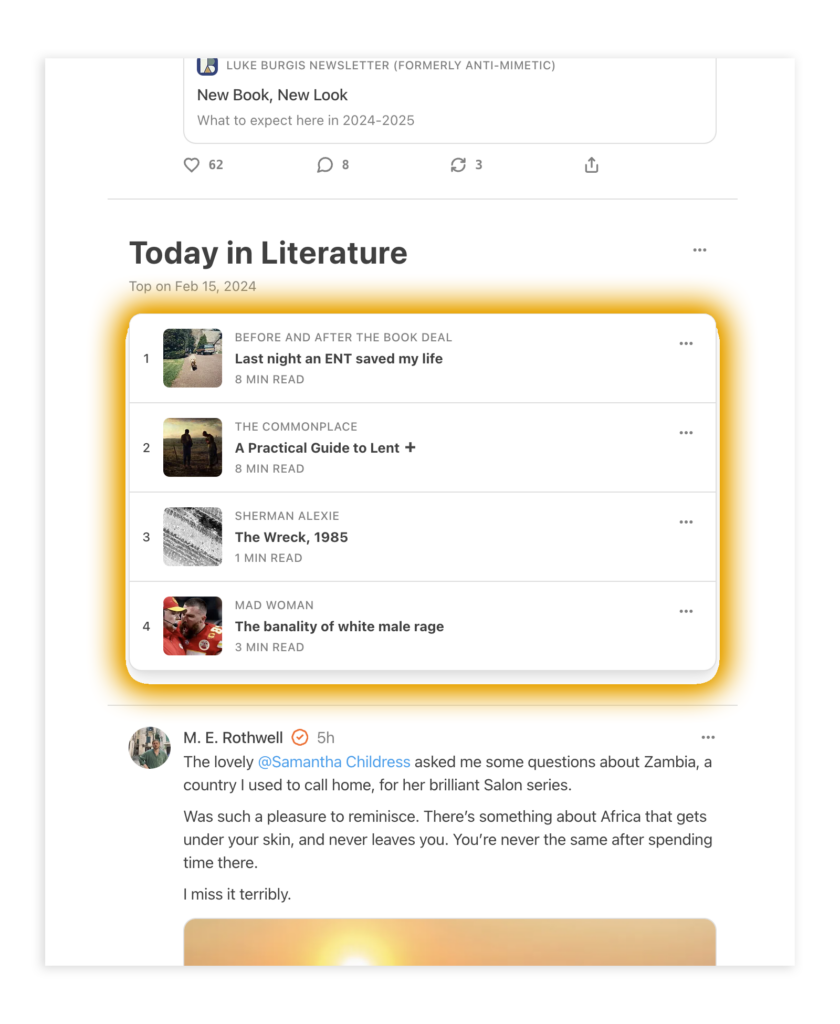
Of course, many of the ones shared via the writing community on Substack are because the algorithm has picked them up due to popularity. So getting your newsletter to trend here, while difficult, is doable with the right steps (we’ll cover below).
Either way, it’s a huge benefit when the writer doesn’t necessarily have to do all the promoting.
Is Substack a good platform for writers?
Yes! Substack is truly a platform to support writers. That’s why the writing community on Substack is so big in the first place. Plus, you’ll find inspiration of quality writing almost anywhere you look because it’s meant for people who prefer the written medium.
Specifically, Substack does a few things writers often need but don’t want to create separately.
It’s both an email list and a website, in a way.
Because Substack allows you to send newsletters to an email list and publish those newsletters online, authors can often use their Substack page as a website if they don’t want to create an author website themselves. In fact, some authors even purchase a domain, and just have the link redirected to their Substack page.
Substack gives you a few options to host your newsletters as well, so your page can look a few different ways.
You can go for a more minimal appearance, like this writer:
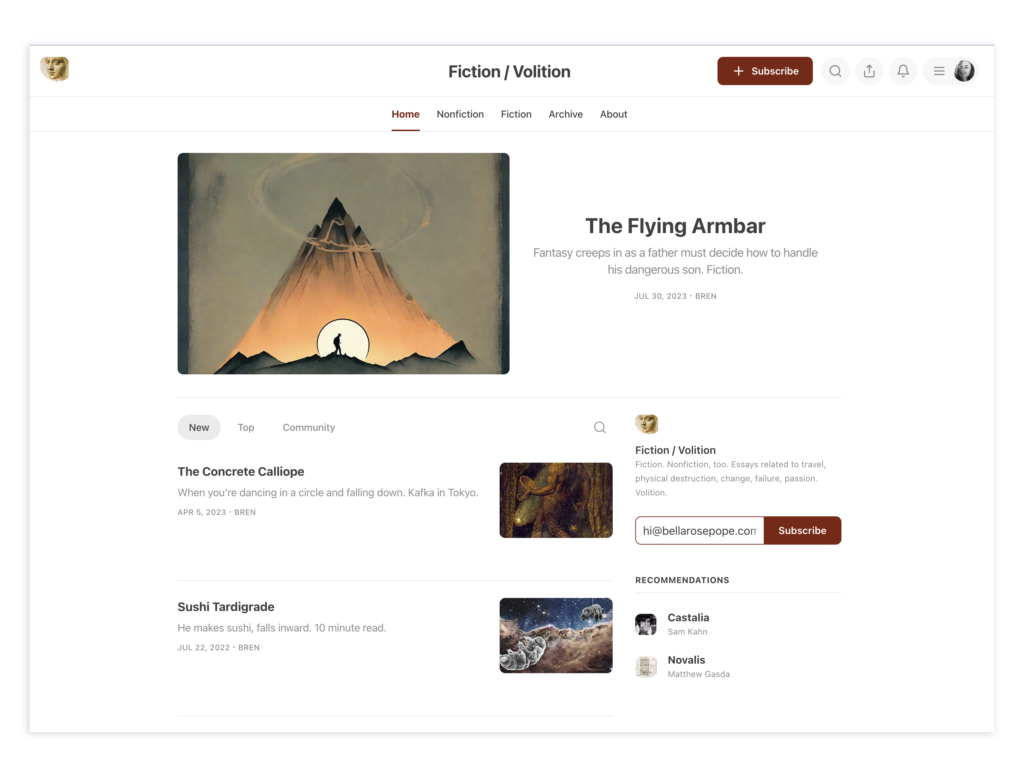
Or you can highly organize your newsletter, especially if you’re someone who has various topics and categories:

This makes Substack a great platform for writers because once you share a newsletter, it’s not gone forever, and can actually entice new fans to sign up to keep reading new ones. This is really helpful for marketing your book repeatedly, as well as getting paid subscribers.
How to Grow a Writing Community on Substack as an Author
Now, you can’t just create a profile and expect to be a part of the writing community on Substack. This takes some time and, importantly, knowing the right ways to spend your time.
So let’s get into some tactics for growing a writing community on Substack as an author.
1. Research
You’ll have to find your “club” of people, so to speak. Some of this can be done from the Notes feature, sure, but you want to help the algorithm out. First, you have to show the platform the type of content and people you want to connect with.
This means doing some research by using the search function.
Keep in mind that Substack results often filter based on the specific keyword you use as it relates to the name of the publication (the @ beneath someone name when in the “People” filter option). This means if you search for something like “Fiction” as in the example below, you’ll find users with those publication names, though they might name it by their own name.
This can also serve as a hack for how to name your own publication for searchability—more on that below.
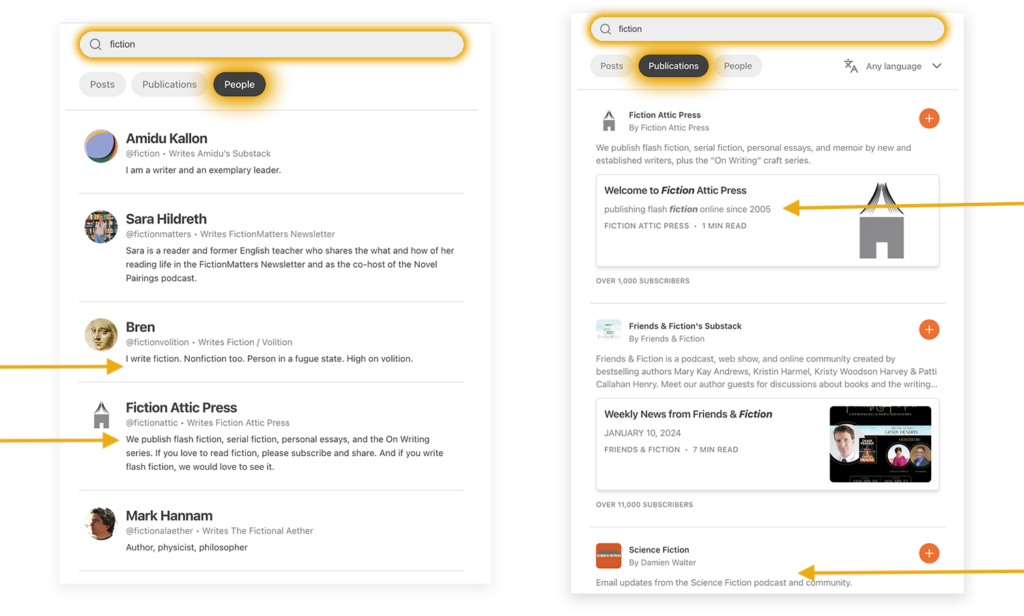
To research and start building your writing community on Substack, go to the search function and:
- Type in a keyword related to the type of writing you want to find
- Choose between search types by clicking “people” or “publications” or “posts”
- Click into a few that fall in line with what you’re seeking
- Subscribe to their publications or follow them to see their presence in your Notes
- Repeat these steps to build a list of people you “follow”, and also subscribe to
To “follow” instead of just subscribing to people, you’ll click on their listing from the search page, and then click the 3 horizontal dots next to the large “Subscribe” button, as you can see below.
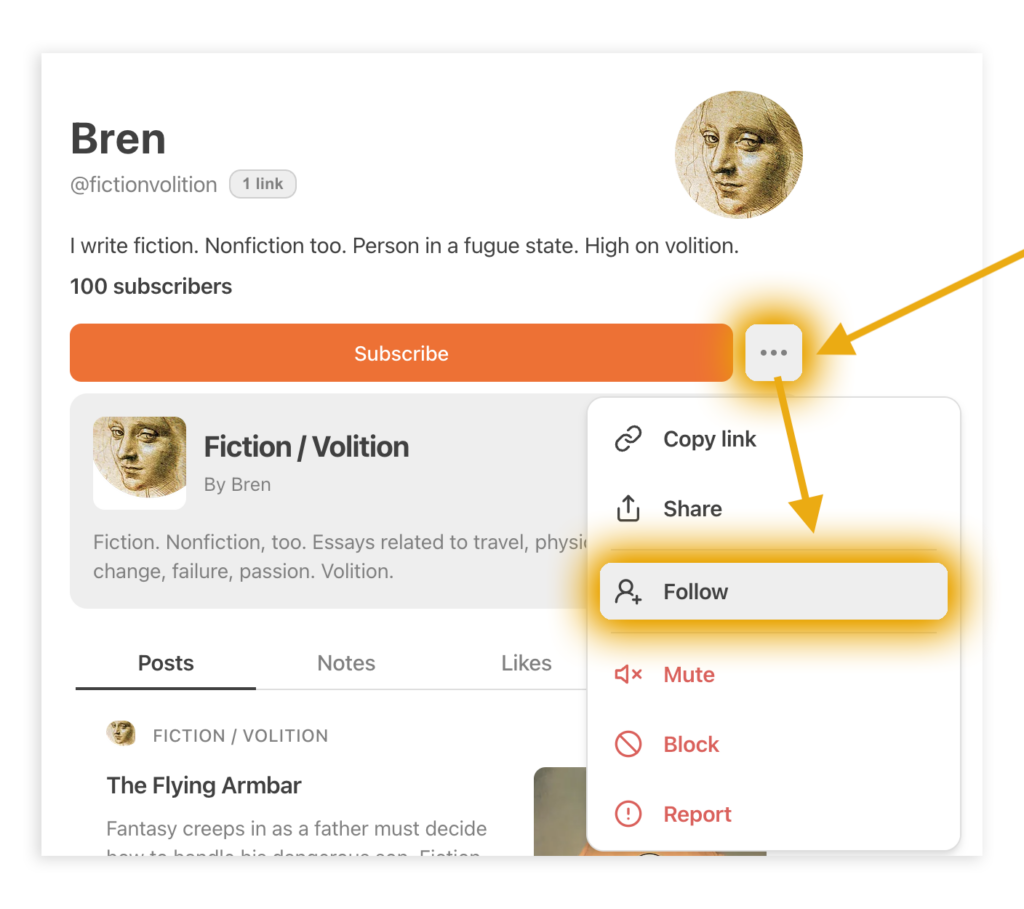
After a while, this will help you build the algorithm so you’ll see more people like that in your Notes field, and it will also show your posts to those types of people, too.
2. Name your newsletter
I put this second because it’s important to understand how your newsletter name (the @ you use and what will appear in the URL) is important for getting people from the writing community on Substack to find you. Utilizing keywords in your newsletter name will help with growth.
For example, you can use your name as your publication name. That’s perfectly acceptable, but it’s less likely you’ll show up high on the search listing when you do that. This might not matter if you have a large list and platform elsewhere, but if you’re starting on Substack, think of what else you can name it.
This will partly have to do with the type of content you’ll write about.
For example, my own Substack is called A Study of Fiction. I use the term “fiction” because I want to attract people who want to learn more about the craft. Specifically, I use “study” because it refers to the style that my newsletter tends to take, one that’s more comprehensive to the breaking down and learning of fiction.
Determine your newsletter name, and follow the prompts to write your description as well. Make sure to use a keyword or two in that too.
NOTE: you can change your newsletter name if you need to. Just keep in mind that each newsletter also get a permanent link, and if you change the name of the newsletter after those links are available on other parts of the web (like shared to Facebook, for example), they will no longer work once the newsletter name has been changed.
3. Newsletter topics
You can write about anything you want. However, keep in mind that most subscribers will sign up for a reason. They want content similar to stuff they see on your Substack page, but also what you promote in the description of your publication.
In order to grow your writing community on Substack, you’ll want to give people what they came for.
This usually means sticking to a set of topics and not veering too far outside of that. If you want to share your fiction writing, for example, you can definitely write a newsletter that has more updates about your life, but if you end up writing a highly political piece when your subscribers expect fiction or updates about your life, you could lose people.
That’ll shrink your writing community on Substack quite a bit.
Create a list of several topics, and systematically go through to check them off, scheduling about one a week. Over time, doing this along with the next steps will help grow your writing community on Substack quite a bit.
4. Share posts
You do have to promote your newsletters. Even though there’s a space on the app for the writing community on Substack to connect, you have to put yourself out there.
Link to a quote or the whole newsletter inside of notes.
You can do this by going to the newsletter’s published page and clicking “Share”. There are options to share to various social networks, including the Notes section on Substack, as you can see below.
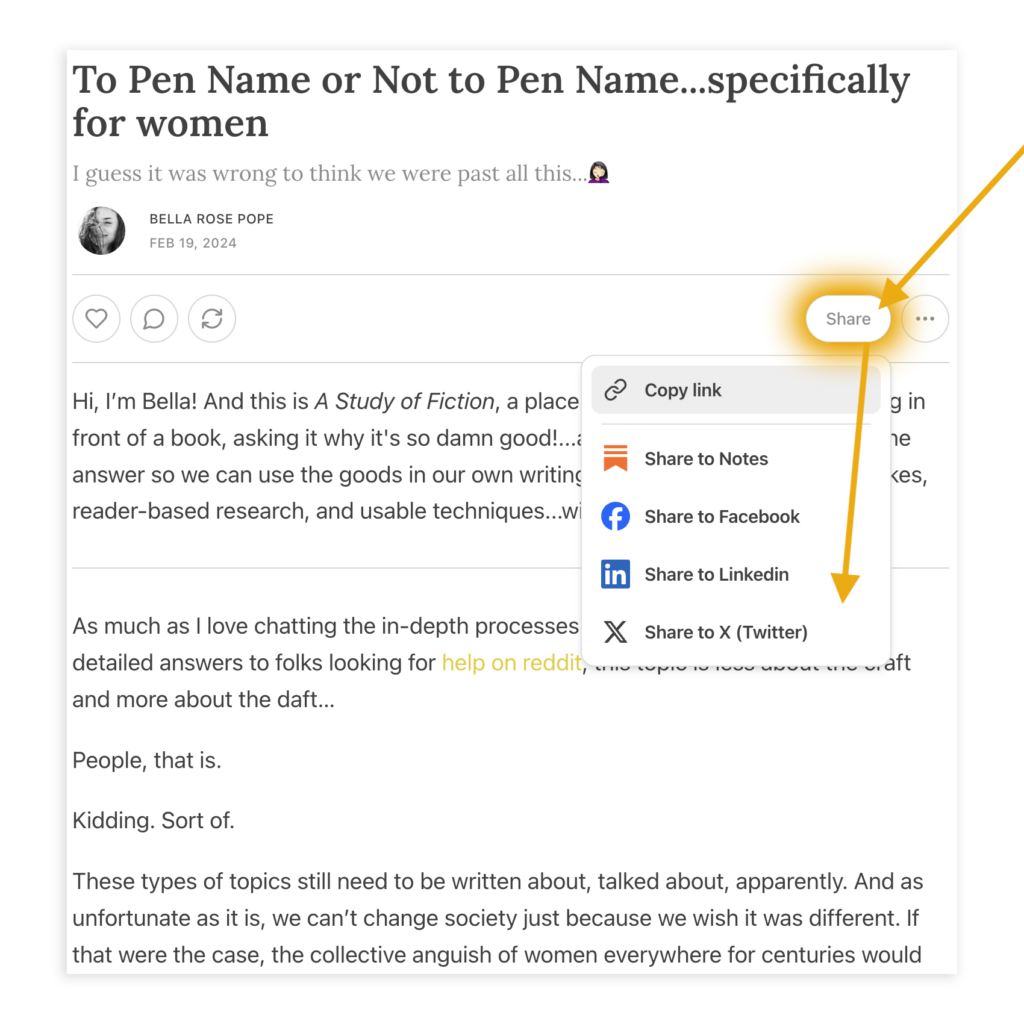
You can also share individual quotes from within the newsletter itself, and those appear differently in the notes feed, but also include a link to the newsletter itself. First, you’ll highlight text on a newsletter, and an options box will appear immediately. Choose your sharing option. Like this:
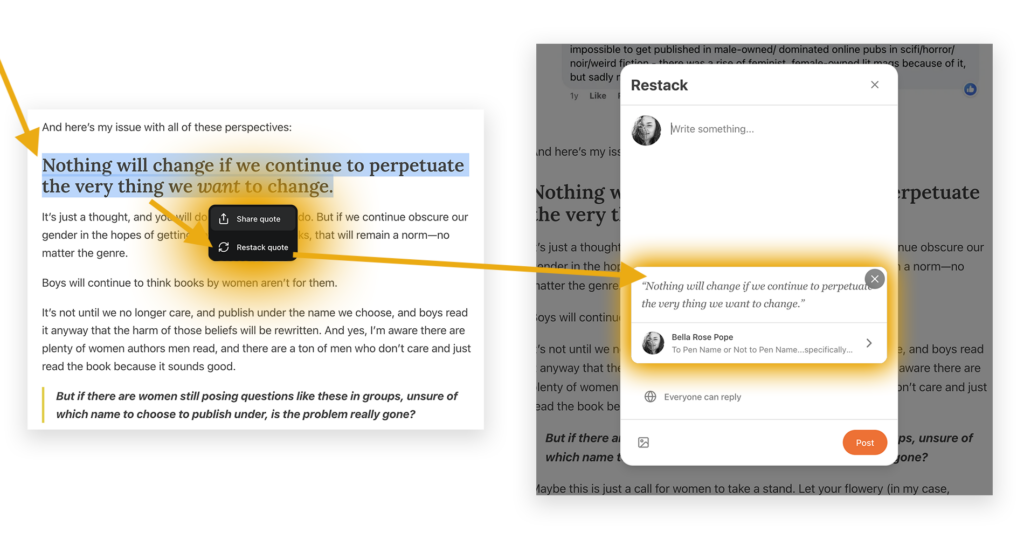
This can help drum up engagement in the writing community on Substack, instead of just looking like you’re sharing your own post. People might also be more intrigued in a specific quote rather than a title, as well.
No matter how or where you choose to share, you definitely should share!
5. Create engagement prompts
Instead of only becoming a part of the conversation, be the reason the conversation exists. This is a huge method of growing the writing community on Substack. After all, the community needs something to discuss, right?
There are a few ways you can do this:
- Asking questions via the Notes section
- Posing questions when you share your newsletter to other feeds
- Creating 1 newsletter a month with prompts in it to get the community chatting
- Creating a polarizing newsletter to spark conversation
With the latter, of course, you have to be careful, especially when it comes to the writing community on Substack.
You want conversation, not the type of discourse that will make you look bad or create conversation so heated that it’ll shrink the writing community on Substack.
That being said, there are a lot of ways you can grow your community. And even within your Substack newsletter, you can create polls that help to further identify what your audience is looking for. This is sort of like feeding the writing community on Substack exactly what they want.
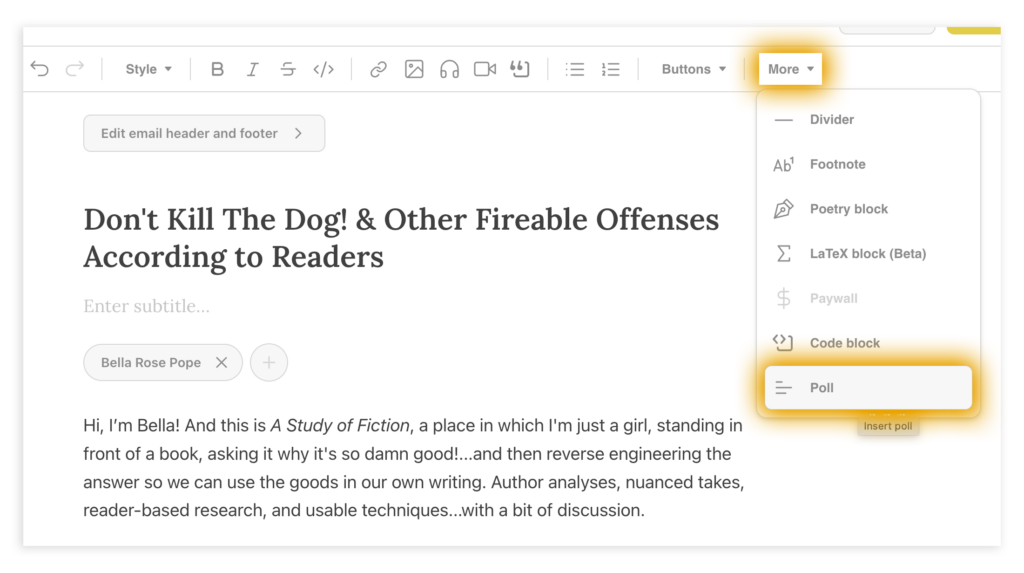
6. Use the chats feature
Now, this is where you start to uplevel the writing community on Substack. In addition to notes, there’s a feature called Chats in which you can talk to your subscribers in a more intimate and private setting.
Here’s an example of what this looks like:
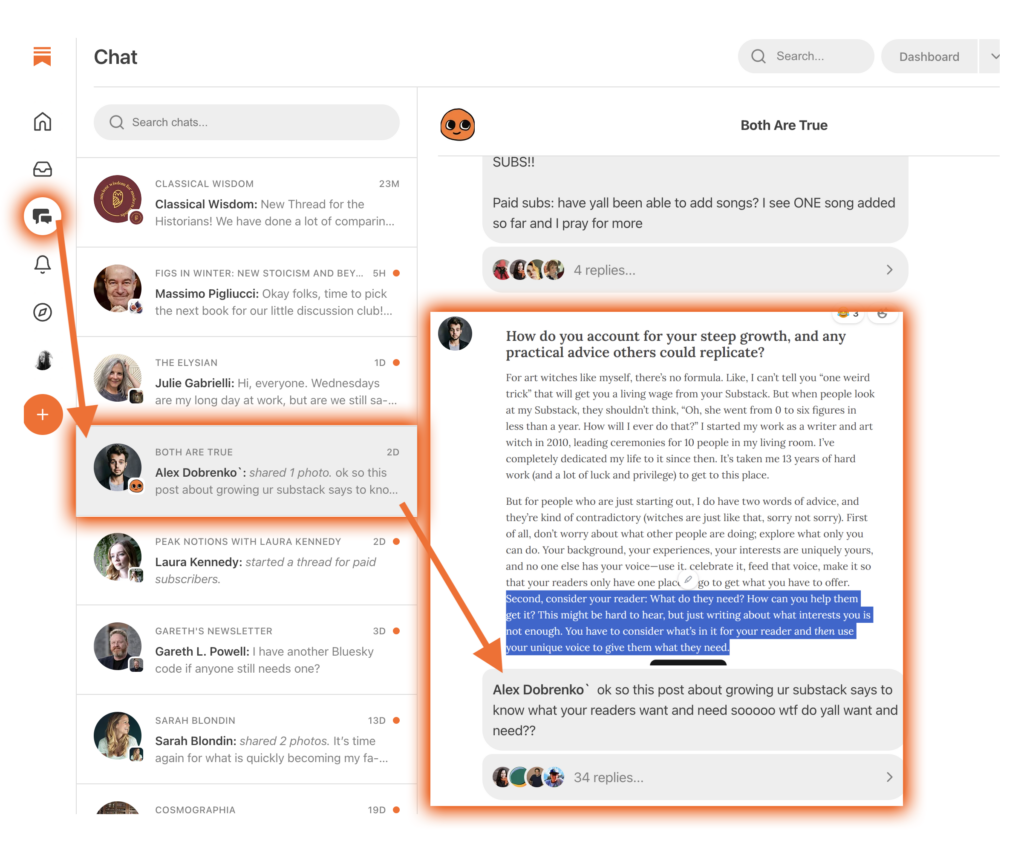
This is an area where you can interact with highly engaged members who are also on the app. It’s a great place to ask questions and get thoughts, especially related to newsletters you want to write.
I always recommend that in order to grow your writing community on Substack for this, you should keep these topics unique to the chat. Don’t devalue the chat section by posing the same question here as you would on Notes. For example, you can easily use this space to offer Q&A for chat members only, and publish those questions and answers in a newsletter.
That way, you’re offering specific attention to the chat, but also utilizing some functions to create more newsletter content, which encourages others to be a part of those chats in the future.
This feature alone is one that’s similar on other social platforms, but specifically important to use to grow the writing community on Substack because it’s used more than other platforms.
While Substack can feel intimidating at first, there are very few other places on the internet with so many talented writers who also appreciate the craft. Get started today, and simultaneously grow your newsletter while growing the writing community on Substack.
